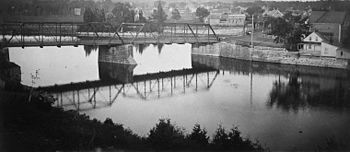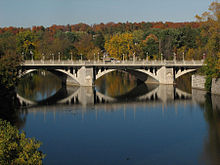Before
http://upload.wikimedia.org/wikipedia/commons/thumb/2/2c/Cummings_Bridge_Ottawa_1896.jpg/350px-Cummings_Bridge_Ottawa_1896.jpg
After
http://upload.wikimedia.org/wikipedia/commons/thumb/9/9f/RideauRV.JPG/220px-RideauRV.JPG
Beautiful but ...
The first Cummings Bridge, erected in 1836, linked Bytown and
Gloucester. The bridge crossed the Rideau River, via the island lying
just south of today's bridge, where the Cummings family lived and ran a
general store. A community called Cummings Bridge sprang up in the
surrounding area. This community would eventually become known as
Vanier.
The early wooden bridge was replaced first by the Cummings family
(who charged a toll for the new bridge) and again later by Ottawa
lumberman (and later mayor) Samuel Bingham in 1893. In thanks for
Bingham's investment, the City renamed the bridge after him. However,
angry community residents tore down the name plaque and threw it in the
river. As a result, we still know the bridge as Cummings Bridge.
Today's bridge, built in 1921, is the bridge's fourth incarnation. In
the summer, you can often spot Ottawa's royal swans from the bridge or
the nearby banks of the Rideau River.
taken from :
http://capitalneighbourhoods.ca/english/sandy-hill/story-266.aspx
The bridge promoted the migration of working-class families from Bytown
to what became Vanier. At the beginning of the 19th century, the lumber
industry was a catalyst for the development of the region. The
soon-to-be capital needed food as well as products and services from the
surrounding countryside. Originally, Vanier had an agricultural
calling, with many gardeners and farmers settling in the area.
The Cummings were located on an ideal site. First, they opened a
general store to serve pioneering families from Junction Gore, the area
that encompassed the headland at the junction of the Rideau and Ottawa
rivers. Under the management of Robert Cummings, eldest son and heir of
the family business, the store flourished and rapidly became a regional
supply centre. Gradually, Robert Cummings diversified his activities and
began to manufacture horse-drawn carriages. His general store was also
the only one to hold a post office and, later, the only telephone
service in town. As a prominent citizen, he was involved in local
politics for almost 50 years.
After 1845, both the population and traffic rapidly increased in the
region. Robert Cummings undertook the construction of a second, stronger
wooden bridge. He collected a toll from its users. The City of Ottawa
built a metal bridge in the early 1890s to meet more adequately the
needs of the community. Much more than a link between the two shores,
Cummings Bridge allowed the continued development of businesses in
Janeville, Clandeboye and Clarkstown.
The Island Today…
Around 1920, the City of Ottawa decided to build a new bridge on the
Rideau River a dozen metres to the north of Cummings Island. The new
bridge, which no longer spanned the island, nevertheless kept the name
of Cummings Bridge. In 1922, the City of Ottawa bought the island and
demolished the general store of the Cummings. No one has inhabited the
island since. The only architectural remains on the island are the
bridge pillars built in 1890. In the 1990s, the municipal council of
Vanier proposed to acquire the island and rebuild the general store to
create a local heritage site, but the plan never materialized.
Taken from : http://www.museoparc.ca/circuitvanier/circuit-vanier-2/montreal-road-circuit/cummings-island/
Friday, November 16, 2012
Subscribe to:
Post Comments (Atom)





No comments:
Post a Comment